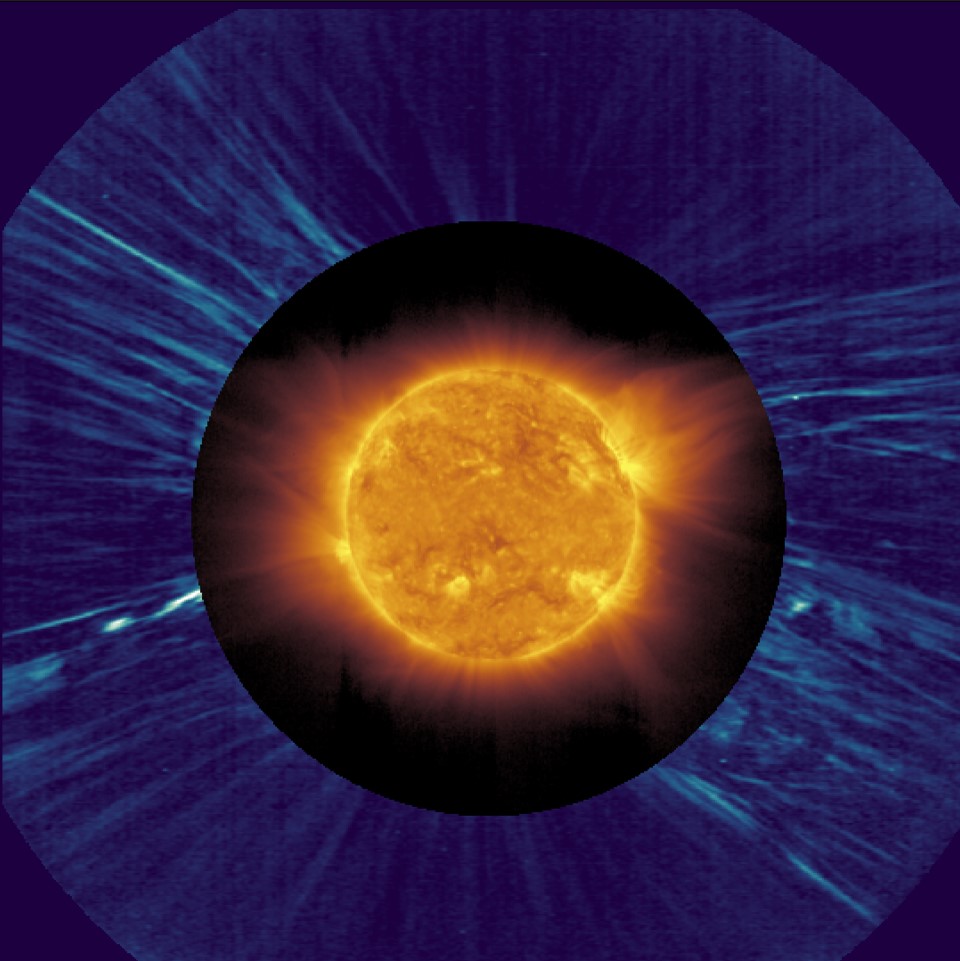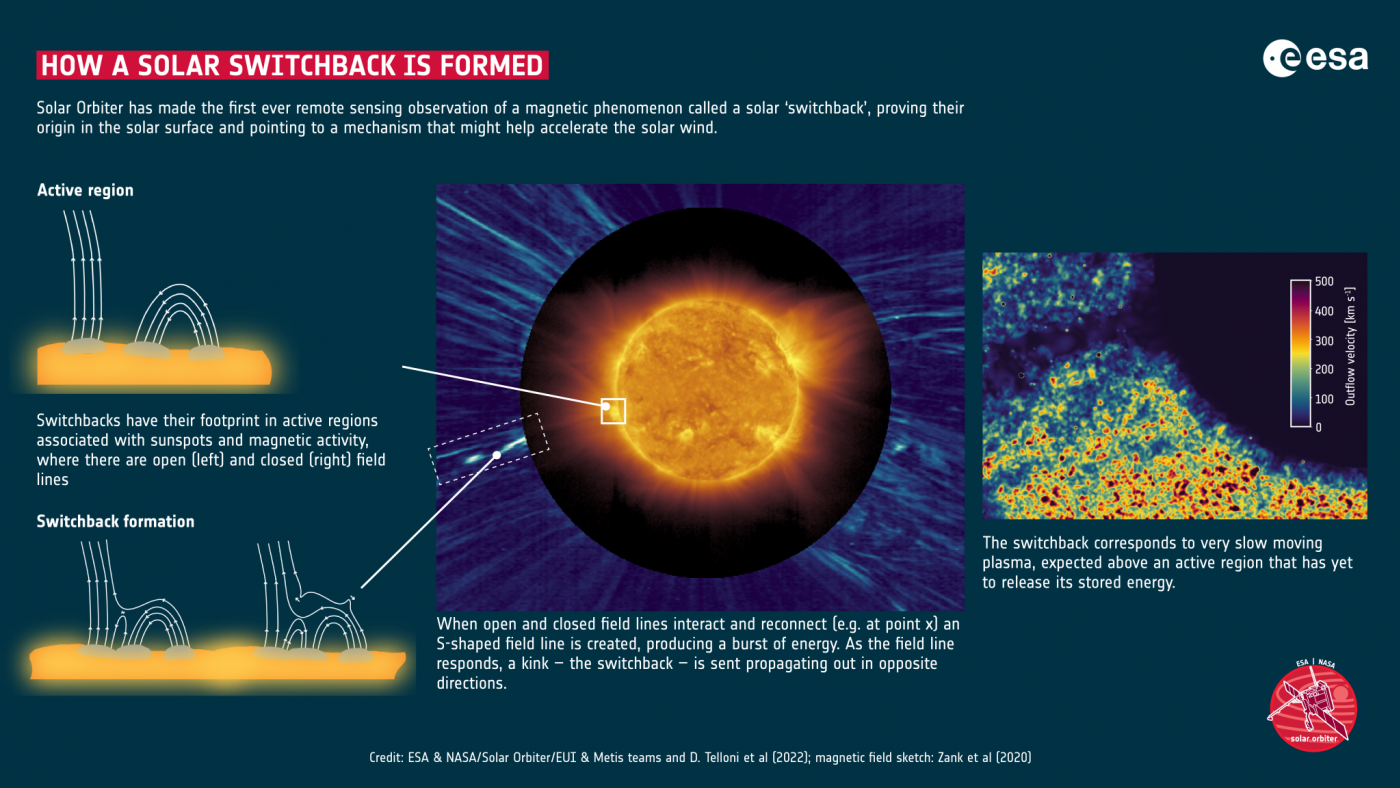
The Sun seen by the Solar Orbiter probe on March 25, 2022. The central image was taken by the EUI (Extreme Ultraviolet Imager) instrument. The outer image was taken by the Metis coronagraph. The processed image revealed the flip (the white/light blue feature in the lower left corner). Credit: ESA & NASA/Solar Orbiter/EUI & Metis Teams and D. Telloni et al (2022)
As part of the Solar Orbiter science support activities and in conjunction with the ERC Synergy WholeSun grant, researchers from CEA Paris-Saclay, together with an international collaboration, have developed advanced numerical simulations to study the formation of structures of the solar wind. These simulations allow studying the interaction of the convection at the solar surface with the magnetic field. They reveal the appearance of twisted magnetic structures that can participate in the creation of switchbacks.
Magnetic folds or "switchbacks" are a sudden reversal of the magnetic field carried by the solar wind. They have been measured by probes since the dawn of the space age. More recently, switchbacks have received increasing interest due to the unprecedented frequency (hundreds during an orbit) with which they are observed by NASA's Parker Solar Probe (launched in 2018) in the near-solar environment. It is thought that the formation and dissipation of switchbacks may play a key role in the formation of the solar wind. Recently, ESA/NASA's Solar Orbiter made the first ever direct imaging observations of large-scale magnetic folding using the Metis instrument (Telloni et al. 2022). This marks a significant advance in understanding the origin and propagation of swithbacks. The ESA infographic (Fig. 1) highlights the elongated, folded structure that propagates away from the Sun (dashed box in the middle left).

The exact mechanism of switchback formation remains to be understood, but there are two main hypothesis:
The mechanism proposed to explain the observations of Telloni et al. (2022) is the reconnection of switchbacks to the solar surface (Zank et al. 2020). In this mechanism, it is the reconnection of magnetic field lines near the solar surface (thus scenario 1), which creates folds in the magnetic field that then propagate into the solar wind.
As part of the Solar Orbiter science support activities and in conjunction with the ERC Synergy WholeSun grant, researchers from CEA Paris-Saclay, as well as an international collaboration including colleagues from the University of Oslo involved in the ERC, have in parallel developed advanced high resolution numerical simulations to study the formation of structures at the base of the solar wind. These magnetohydrodynamic simulations, including the treatment of solar radiation, allow the study the nonlinear and complex interaction of the convection at the solar surface with the magnetic field.
Figure 2 shows the behaviour of the Sun's magnetic field after being driven by turbulent surface convection. The magnetic field is twisted and organized into braids, with the formation of smaller-scale vortex flows that launch torsional waves and create "solar tornadoes." Finley et al. (2022) argue that the torsional waves generated in these twisted fields could travel up into the solar wind and dissipate there through turbulence to form switchbacks (see Figure 3). As the twisted magnetic field structures form at a characteristic size of about 10Mm, this mechanism naturally explains the fragmented nature of the swithbacks observed by Parker Solar Probe. Fargette et al (2021) had previously estimated that the size of the switchback packets (shown in Figure 3), when traced to the solar surface, was about the same characteristic scale as measured in the simulation.

Fig 2. 3D visualization of the magnetic field in the simulation of Finley et al. (2022). The simulation domain is 24Mm x 24Mm (the Earth's diameter is about 13Mm, and the Sun's about 1400Mm, for scale). The solar surface and its convection are colored in red and blue to distinguish the hot plasma (in red) which rises in the center of the granules from the cooling plasma (in blue) which descends between the two. The action of the Sun's convection on its magnetic field causes it to be organized in braided structures. In addition, strong regions of magnetic field can locally suppress the Sun's convection and create enhanced downflows that generate vortex-like structures that dynamically twist the magnetic field, creating "solar tornadoes."

Fig 3. Schematic describing the formation of the structure at the base of the solar wind from magnetohydrodynamic simulations by Finley et al. (2022). A 3D visualization of the twisted magnetic structures in the simulation domain is shown in the lower left (with the Earth to scale). Slices of the magnetic energy density and flux variation near the top of the simulation domain are displayed above. The densities, temperatures, mass fluxes, and magnetic energy fluxes are all enhanced within the twisted magnetic fields. This creates a natural structuring in the solar atmosphere with a horizontal scale of about 10Mm. The solar wind extends from the simulation, causing these variations so that at the orbital distance of NASA's Parker Solar Probe, about 13-20 solar radii (or 14,000Mm) from the Sun, switchbacks have developed. A time series of the radial magnetic field observed by Parker Solar Probe, near the Sun, is reproduced visually at the top of the diagram.
There are most likely multiple ways to generate switchbacks, from interchange-type reconnection to turbulent torsional wave dissipation. Several of these mechanisms can also work in tandem. Future work at CEA Paris-Saclay will explore the heating and structuring of the solar atmosphere under various magnetic configurations, helping to interpret observations from NASA's Parker Solar Probe and ESA/NASA's Solar Orbiter.
Starting in 2025, Solar Orbiter's orbit will begin to rise out of the plane of the planets, allowing us to see for the first time over an extended period (several weeks) the poles of the Sun. Who knows what surprises await us, but it is certain that the observations of polar dynamics and magnetism will be revolutionary.
Contacts Irfu: Allan-Sacha BRUN, ADAM FINLEY, Antoine STRUGAREK
References:
• Structure and evolution of the Universe › Planets, star's formation and dynamics, interstellar medium
• Institute of Research into the Fundamental Laws of the Universe • Department of Astrophysics (DAp) // UMR AIM
• Laboratory Dynamics of Stars, Exoplanets and their Environment
